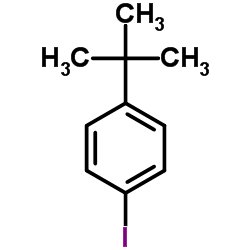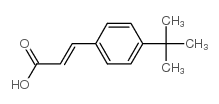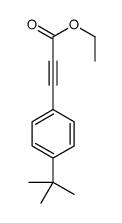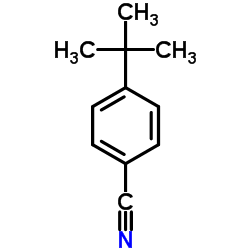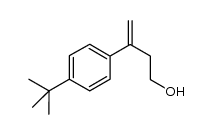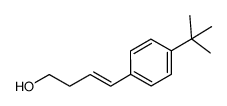772-38-3
| Name | 4-tert-Butylphenylacetylene |
|---|---|
| Synonyms |
1-tert-butyl-4-ethynylbenzene
MFCD00190197 |
| Density | 0.877 g/mL at 25 °C(lit.) |
|---|---|
| Boiling Point | 70 °C2 mm Hg(lit.) |
| Molecular Formula | C12H14 |
| Molecular Weight | 158.24000 |
| Flash Point | 180 °F |
| Exact Mass | 158.11000 |
| LogP | 2.96540 |
| Index of Refraction | 1.528-1.53 |
|
Section1. IDENTIFICATION OF THE SUBSTANCE/MIXTURE Product name: 4-tert-Butylphenylacetylene Section2. HAZARDS IDENTIFICATION Classification of the substance or mixture According to Regulation (EC) No1272/2008 Eye irritation (Category 2) Acute aquatic toxicity (Category 1)
Chronic aquatic toxicity (Category 1) According to European Directive 67/548/EEC as amended. Very toxic to aquatic organisms, may cause long-term adverse effects in the aquatic environment. Label elements Pictogram Signal wordWarning Hazard statement(s) H319Causes serious eye irritation. H410Very toxic to aquatic life with long lasting effects. Precautionary statement(s) P273Avoid release to the environment. P305 + P351 + P338IF IN EYES: Rinse cautiously with water for several minutes. Remove contact lenses, if present and easy to do. Continue rinsing. P501Dispose of contents/container to an approved waste disposal plant. Hazard symbol(s) NDangerous for the environment R-phrase(s) R50/53Very toxic to aquatic organisms, may cause long-term adverse effects in the aquatic environment. S-phrase(s) S36/37Wear suitable protective clothing and gloves. S60This material and its container must be disposed of as hazardous waste. S61Avoid release to the environment. Refer to special instructions/ Safety data sheets. Other hazards - none Section3. COMPOSITION/INFORMATION ON INGREDIENTS Formula: C12H14 Molecular Weight: 158,24 g/mol CAS-No.EC-No.Index-No.ClassificationConcentration 4-tert-Butylphenylacetylene 772-38-3--Eye Irrit. 2; Aquatic Acute 1;- Aquatic Chronic 1; H319, H410 N, R50/53 For the full text of the H-Statements mentioned in this Section, see Section 16. Section4. FIRST AID MEASURES If inhaled If breathed in, move person into fresh air. If not breathing give artificial respiration Consult a physician. In case of skin contact Wash off with soap and plenty of water. Consult a physician. In case of eye contact Flush eyes with water as a precaution. If swallowed Never give anything by mouth to an unconscious person. Rinse mouth with water. Consult a physician. Section5. FIRE-FIGHTING MEASURES Suitable extinguishing media Use water spray, alcohol-resistant foam, dry chemical or carbon dioxide. Special protective equipment for fire-fighters Wear self contained breathing apparatus for fire fighting if necessary. Section6. ACCIDENTAL RELEASE MEASURES Personal precautions Avoid breathing vapors, mist or gas. Ensure adequate ventilation. Environmental precautions Prevent further leakage or spillage if safe to do so. Do not let product enter drains. Discharge into the environment must be avoided. Methods and materials for containment and cleaning up Keep in suitable, closed containers for disposal. Section7. HANDLING AND STORAGE Precautions for safe handling Keep away from sources of ignition - No smoking. Take measures to prevent the build up of electrostatic charge. Conditions for safe storage Store in cool place. Keep container tightly closed in a dry and well-ventilated place. Containers which are opened must be carefully resealed and kept upright to prevent leakage. Section8. EXPOSURE CONTROLS/PERSONAL PROTECTION Personal protective equipment Respiratory protection Where risk assessment shows air-purifying respirators are appropriate use a full-face respirator with multi-purpose combination (US) or type ABEK (EN 14387) respirator cartridges as a backup to engineering controls. If the respirator is the sole means of protection, use a full-face supplied air respirator. Use respirators and components tested and approved under appropriate government standards such as NIOSH (US) or CEN (EU). Hand protection The selected protective gloves have to satisfy the specifications of EU Directive 89/686/EEC and the standard EN 374 derived from it. Handle with gloves. Eye protection Safety glasses with side-shields conforming to EN166 Skin and body protection Choose body protection according to the amount and concentration of the dangerous substance at the work place. Hygiene measures Handle in accordance with good industrial hygiene and safety practice. Wash hands before breaks and at the end of workday. Section9. PHYSICAL AND CHEMICAL PROPERTIES Appearance Formliquid Colourcolourless Safety data pH no data available Melting pointno data available Boiling point70 °C at 3 hPa - lit. Flash point82,2 °C - closed cup Ignition temperature no data available Lower explosion limit no data available Upper explosion limit no data available Density0,877 g/cm3 at 25 °C Water solubilityno data available Partition coefficient: log Pow: 4,394 n-octanol/water Section10. STABILITY AND REACTIVITY Chemical stability Stable under recommended storage conditions. Conditions to avoid no data available Materials to avoid Strong oxidizing agents Hazardous decomposition products Hazardous decomposition products formed under fire conditions. - Carbon oxides Section11. TOXICOLOGICAL INFORMATION Acute toxicity no data available Skin corrosion/irritation no data available Serious eye damage/eye irritation no data available Respiratory or skin sensitization Germ cell mutagenicity no data available Carcinogenicity IARC: No component of this product present at levels greater than or equal to 0.1% is identified as probable, possible or confirmed human carcinogen by IARC. Reproductive toxicity no data available Specific target organ toxicity - single exposure no data available Specific target organ toxicity - repeated exposure no data available Aspiration hazard no data available Potential health effects InhalationMay be harmful if inhaled. May cause respiratory tract irritation. IngestionMay be harmful if swallowed. SkinMay be harmful if absorbed through skin. May cause skin irritation. EyesMay cause eye irritation. Signs and Symptoms of Exposure To the best of our knowledge, the chemical, physical, and toxicological properties have not been thoroughly investigated. Additional Information RTECS: no data available Section12. ECOLOGICAL INFORMATION Toxicity no data available Persistence and degradability no data available Bioaccumulative potential no data available Mobility in soil no data available PBT and vPvB assessment no data available Other adverse effects Very toxic to aquatic organisms, may cause long-term adverse effects in the aquatic environment. Section13. DISPOSAL CONSIDERATIONS Product This combustible material may be burned in a chemical incinerator equipped with an afterburner and scrubber. Observe all federal, state, and local environmental regulations. Contact a licensed professional waste disposal service to dispose of this material. Contaminated packaging Dispose of as unused product. Section14. TRANSPORT INFORMATION ADR/RID UN-Number: 3082 Class: 9Packing group: III Proper shipping name: ENVIRONMENTALLY HAZARDOUS SUBSTANCE, LIQUID, N.O.S. (4-tert- Butylphenylacetylene) IMDG UN-Number: 3082 Class: 9Packing group: IIIEMS-No: F-A, S-F Proper shipping name: ENVIRONMENTALLY HAZARDOUS SUBSTANCE, LIQUID, N.O.S. (4-tert- Butylphenylacetylene) Marine pollutant: No IATA UN-Number: 3082 Class: 9Packing group: III Proper shipping name: Environmentally hazardous substance, liquid, n.o.s. (4-tert-Butylphenylacetylene) Section15. REGULATORY INFORMATION This safety datasheet complies with the requirements of Regulation (EC) No. 1907/2006. Section16. OTHER INFORMATION Text of H-code(s) and R-phrase(s) mentioned in Section 3 Aquatic AcuteAcute aquatic toxicity Aquatic ChronicChronic aquatic toxicity Eye Irrit.Eye irritation H319Causes serious eye irritation. H410Very toxic to aquatic life with long lasting effects. NDangerous for the environment R50/53Very toxic to aquatic organisms, may cause long-term adverse effects in the aquatic environment. Further information Copyright 2010 Co. License granted to make unlimited paper copies for internal use only. The above information is believed to be correct but does not purport to be all inclusive and shall be used only as a guide. The information in this document is based on the present state of our knowledge and is applicable to the product with regard to appropriate safety precautions. It does not represent any guarantee of the properties of the product. Co., shall not be held liable for any damage resulting from handling or from contact with the above product. See reverse side of invoice or packing slip for additional terms and conditions of sale. |
| Hazard Codes | N,Xi |
|---|---|
| Risk Phrases | R50/53 |
| Safety Phrases | S36/37-S60-S61 |
| RIDADR | UN 3082 9/PG 3 |
| WGK Germany | 3 |
| HS Code | 2902909090 |
|
~10% 
772-38-3 |
| Literature: Canadian Journal of Chemistry, , vol. 79, # 5-6 p. 878 - 887 |
|
~83% 
772-38-3 |
| Literature: Tetrahedron, , vol. 63, # 30 p. 7018 - 7026 |
|
~% 
772-38-3 |
| Literature: Tetrahedron, , vol. 63, # 30 p. 7018 - 7026 |
|
~% 
772-38-3 |
| Literature: Tetrahedron, , vol. 53, # 45 p. 15515 - 15534 |
|
~% 
772-38-3 |
| Literature: Organic and Biomolecular Chemistry, , vol. 11, # 39 p. 6707 - 6712 |
|
~% 
772-38-3 |
| Literature: Journal of Organic Chemistry USSR (English Translation), , vol. 8, p. 1727 - 1729 Zhurnal Organicheskoi Khimii, , vol. 8, p. 1690 - 1692 |
|
~% 
772-38-3 |
| Literature: Chinese Journal of Chemistry, , vol. 29, # 11 p. 2350 - 2354 |
| Precursor 4 | |
|---|---|
| DownStream 9 | |
| HS Code | 2902909090 |
|---|---|
| Summary | 2902909090 other aromatic hydrocarbons。Supervision conditions:None。VAT:17.0%。Tax rebate rate:9.0%。MFN tariff:2.0%。General tariff:30.0% |



